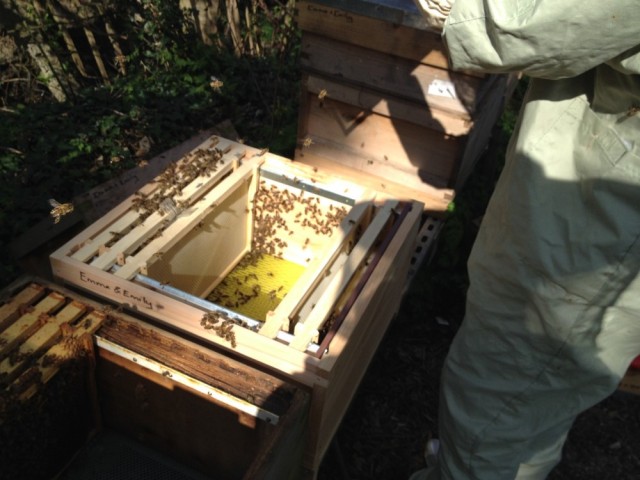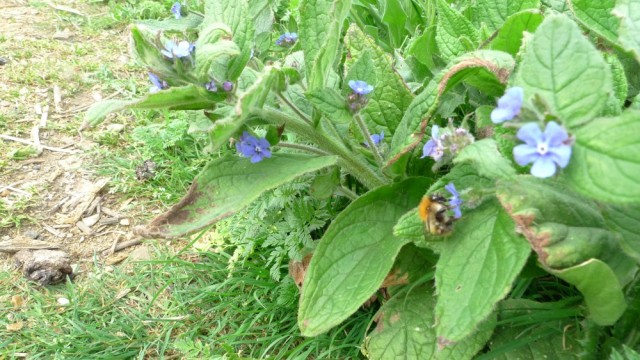Last weekend was warm, so Emma and I did a shook-swarm on our two strongest hives, Myrtle and Chilli. We worked as a team, Emma shaking the bees into a fresh brood box with new foundation, then passing me the old frames to bag up in bin bags. Pat kindly got a fire going for us, into which the old frames and brood went, hopefully along with a load of varroa mites. Emma has written a great blog post about the day and her thoughts on the shook-swarm: A tale of two colonies.
Above you can see Emma looking at a frame in Myrtle’s hive. It is old, brown comb which could be harbouring disease.
Emma shaking the bees in – she was very good at this and our bees are so gentle they didn’t get at all moody with us. As you can see, it was a nice sunny day. The gap in the middle gives space to shake the bees in and then we filled up the gap with frames of foundation before putting a feeder on top of the crown board and closing the hive up.
If you look closely, you can see a grey clip protruding in-between the top bars of the new hive. We hung Queen Myrtle in a cage between the frames so that she stayed safe and the workers felt comforted by her smell. They will notice very quickly if her pheromones are missing and become unsettled.
We fed the colonies with strong 2:1 sugar solution syrup, which is essential to do following a shook-swarm. Worker bees have eight wax glands on the underside of their abdomens. To produce wax, they will consume nectar (or the sugar solution we provide) and hang together in chains for warmth. The sugar and warmth causes tiny wax scales to be secreted from their wax glands, which they then chew and manipulate into comb using their mandibles and forelegs.
Emma has gone back several times in the week to top up their syrup. Colonies differ in how much syrup they take in after a shook-swarm – Chilli’s hive has consumed a lot more syrup, even though she probably has slightly less bees. Myrtle’s hive has been taking less down, so they are probably collecting nectar instead. Green alkanet (evergreen bugloss) is out now and we saw lots of sweet common carder bees working it. It’s a member of the borage family but more common than borage, so a very important wildflower for bees.
Yesterday we did a quick check inside Myrtle and Chilli’s hives to make sure all was well after the shook-swarm. The workers were on about five central combs in Myrtle’s hive. We saw Myrtle and – even better – rows of neatly laid eggs! The workers had been even busier in Chilli’s hive and were on about eight frames. We spotted Chilli but did not see any eggs yet, though the sky was quite overcast so we may have missed them.
Look how white and clean the new comb the bees have been drawing is.
Tom did a test last week on Chamomile’s hive using a small sample of about 30 worker bees, and was able to determine that nosema is present, though his test does not tell him how badly the bees are infected. He has kindly made us up a thymol solution, which we will spray lightly on her bees next weekend.
Afterwards, we had some cake. Jayne had brought some fab scones with jam and this is a honey loaf I made.
Today I went down to Northfields allotment to help out with their Radbourne walk wildlife project again. We cleared another section of soil before planting it with a wildflower mix containing poppies, cornflowers and some other wild flowers. English bluebells will also be going in. Nettles and green alkanet are being left to grow along the fence as they are good food for butterflies and bees.
Another stag beetle loggery was created. The logs need to be put deep in the soil, as the stag beetle larvae prefer rotten wood. The protruding wood will be good for solitary bees to nest in.
My reasons for helping out with the project are not entirely altruistic, as a nice lady called Jasmine makes sure we are very well catered for. There was a tea break with three types of cake followed by a later lunch of delicious vegetable curry with rice and tomato chutney. In-between eating/digging I also paid for our new allotment plot so that Thomas and I can move our bees there, once we’ve got the plot ready. Everyone I met seemed very happy that bees will be coming and appreciative of the benefits of having pollinators on the allotment.








Reblogged this on Linda's wildlife garden and commented:
awesome post
LikeLike
Thanks Linda 🙂
LikeLike
Great news about the plot Emily just the keys now and we can get on with building the apiary. I have been busy salvaging materials and should soon be good to go. I will also look forward to seeing all the wild flowers when they come up.
LikeLike
Hi Tom, thanks for all the salvaging you’ve been up to. Christina gave me a key so I’ll send you a text about that.
LikeLike
Very nice . . . but still looks like a lot of work. I could handle the eating part well enough . . .
LikeLike
Oh it is a lot of work, the shook-swarm took about two hours for the two hives including all the preparations and burning etc. And it is quite physical work, which is why cake afterwards is very welcome!
LikeLike
Hi Emily. so enjoy following, and thank you for the link to Emma’s blog. As I sit here on April 6 looking out my window at 12 inches of snow around my closest hive I’m thinking, “You girls are too much!” I just love your attention to detail and spirit of investigation and implementation….and cake! The shook swarm method is not part of our routines here in the U.S. however, American Foulbrood is devastating (we burn all used equipment but I do salvage the wax) and we primarily suffer up here in the north from the practice of bringing packages of bees up from the Southern U.S. where they are shook from commercial hive operations. Bad plan. Happily, a big movement is taking hold to raise Northern disease resistant bees and I will be the lucky recipient of bees from two separate apiaries this spring for my new site on a friend’s property. A neighbor and I are planting an enormous garden. I will include Nettles as I love it for tea and did not think of if before your post. We transplanted thyme for around and under the hives last fall to help deter varroa. OK, enough from me.
LikeLike
Thanks for the lovely long comment, I do like to hear all about other people’s bees. Sorry that things are moving so slowly where you are, you must be dying to see your bees again. Bees in the south will be used to a completely different climate, so as you say it makes much more sense to keep local northern raised bees. How lovely to have an enormous garden to keep them in. Butterflies lay their eggs on nettles and I see all kinds of bees on them. I adore the smell of thyme – it makes good smoker fuel too.
LikeLike
Hi Emma, I am a keen advocate of shook swarms. From your blog it sounds like you burned the frames (both wax and woodwork). Is that the case? Why did you think it was necessary to burn the wood? Was it just because it was to much effort to clean them up?
I am sure your bees will befit from their lovely new home.
LikeLike
Hi Barny, thanks for your comment. I know we could have boiled the frames in washing soda solution, but to be honest I don’t have time to do that, not when I’m working full time and getting ready for my wedding in May. For me the few pounds I would save by keeping the woodwork just isn’t worth it, the time saved by buying new frames is worth more to me.
LikeLike
Emily, you will have got rid of the varroa mites that were in the comb, a majority of those present, but there will also be phoretic mites that will soon build up in numbers again. I suggest that you insert into the brood nest a comb with comb about to be sealed but no already sealed brood. Leave it for a few days until mostly sealed and then remove and destroy the sealed brood, which will contain most of the remaining mites.
LikeLike
Thanks Chris, the thing is my only hive with brood at the moment (Chamomile’s) has nosema, so I’d rather not move a comb from hers. We did oxalic acid treatment in winter and the monitoring board drop has been extremely low in our hives when we’ve had the board in, so I’m happy that we don’t have a big varroa problem on our hands.
LikeLike
The allotment sounds a great project. My first mason bees have arrived over hear and chosen the holes in the drilled wood part rather than bamboo in their new hotel. Have you drilled holes in the logs in the wood pile or are you leaving them until wood boring beetles do it?
LikeLike
That’s interesting that they preferred the drilled wood. I believe there are plans to drill some holes in the logs, but that hasn’t been done yet.
LikeLike
It’s an interesting method. I wonder why the bees didn’t get annoyed when you shook them off their racks like that.
LikeLike
Nothing much phases our bees – especially Myrtle’s hive. One of the Ealing beekeepers commented last week that they hardly seem like bees!
LikeLike